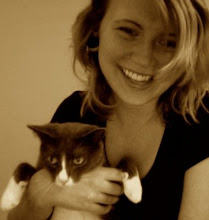First of all, some of the vocabulary that we went over are terms for a certain type of massaging motion.
- Effleurage- a long, gliding stroke; used most frequently.
- Petrissage- Kneading strokes.
- Vibration or Shaking- quick, short rubbing motion which stimulates circulation.
- Compression- Pumping strokes that push blood out of a region, then allow it to return.
- Friction- A more firm, brisk stroke that is beneficial at breaking up scar tissue or adhesions in the muscles.
- Tapotement- Tapping or light, striking stokes; stimulating to the body.
After this initial inspection, you work down the provided list of vocabulary from the dog's head to tail, as well as down the legs, chest, and belly. Each different massaging motion should be followed up by the gently and flowing effleurage strokes. When the shoulders and hips are warmed up via massage, you can gently extend them forward and back. If your dog is not willingly tensing his muscles and is fully relaxed, the stretching motion will relieve some tension and improve the range of motion. Do not force the leg farther than what is comfortable for the animal!
Jen also demonstrated Thumb-gliding(gentle, forward strokes with the thumbs), V-spread(Thumb-gliding apart in a V shape), and "angle wings" which I felt would be more appropriately called "knuckle kneading," as that is exactly what it was..
You can also gently massage your canine's gums if you and the dog are comfortable with this.
You can also grasp the tail and gently pull it up, down, and to each side. This is especially good before and after swimming as a long tail will act as a dog's rutter. The caudal and gluteal muscles will become sore without ample stretching due to a buildup of lactic acid; humans also experience soreness from this cause.
Also, here are a few provided resources which I plan to investigate.
- Canine Massage Certification Program at the Boulder College of Massage Therapy,
- Massage for Dogs (Home Massage for Dogs),
- TTouch - fascinating technique!

No comments:
Post a Comment